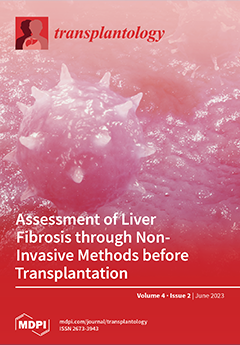Background: Despite great progress in graft survival and complication rates, pronounced inflammatory responses are common after pancreas transplantation (PT). Subsequent to the first postoperative increase in inflammatory markers, we have frequently observed a second peak of C-reactive protein (CRP) and white blood cells (WBCs) following PT. This analysis is to assess the incidence and clinical relevance of late-onset increases in inflammatory markers following PT. Materials and methods: We analyzed all consecutive PTs over a 20-year period. The second peak of CRP (SCP) and WBCs (SWP) was defined as an increase >3 days after PT subsequent to a relevant initial decrease. Results: Of 116 patients, 60 (51.7%) developed SCP. SCP was not associated with pancreas graft loss or with thrombosis at discharge or at 90 days after PT (6.7% vs. 0.0%,
p = 0.1; 8.3% vs. 1.8%,
p = 0.2; and 15.0% vs. 3.6%,
p = 0.06, respectively). Patients with SCP had more complications overall at discharge and at 90 days (85.0% vs. 50.0%,
p < 0.001 and 93.3% vs. 76.8%,
p = 0.02). In multivariable analysis, SCP was significantly associated with pre-transplant HbA1c (OR 2.1 (95% CI: 1.3–3.8);
p = 0.005) and female gender (OR 0.03 (95% CI: 0.004–0.14);
p ≤ 0.001). No significant association was found between SCP and pancreas cold ischemia time (OR 1.0 (95% CI: 1.0–1.0);
p = 0.1), donor age (OR 1.01 (95% CI: 0.96–1.06);
p = 0.7), recipient age (OR 0.9 (95% CI: 0.9–1.0);
p = 0.1), or recipient BMI (OR 0.9 (95% CI: 0.9–1.4);
p = 0.3). SWP did not differ in patients with or without SCP (
p = 0.07) and there was no correlation with pancreas graft loss or relaparotomy (
p = 0.3 and
p = 0.6, respectively). Insulin-free graft survival after 1, 5, and 10 years did not differ between patients with SCP and those without SCP (95.0%, 90.2%, 90.2% vs. 96.1%, 91.2%, 88.7%, respectively;
p = 0.964). Conclusion: Late-onset inflammatory reactions are frequently seen in PT and are correlated with higher overall complication rates. They are not correlated, however, with graft-specific complications or insulin-free graft survival.
Full article




